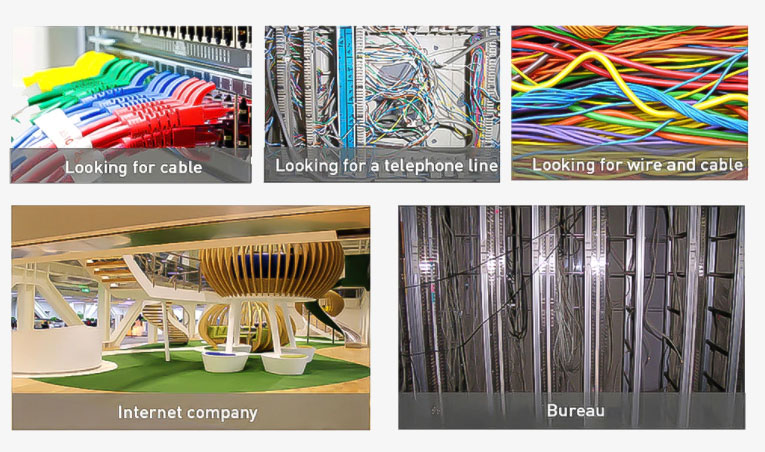The network cable tester has a large LCD screen and is able to store, calibrate, memorise and retrieve data. The multifunctional network cable tester can find network cables, telephone cables, BNC coaxial cables, USB cables and other metal cables.
- Network testers analyzers can test open, short, cross, reverse, paired connections and locate cable breaks on network, telephone, BNC and USB cables with a visual display on the LCD.
- The ethernet cable connection tester performs crosstalk tests on network cables and solves potential problems with slow internet speeds.
- The ethernet cable tracer can find the required target cable among numerous network cables, telephone cables, coaxial cables and other various metal cables, and enables you to find the cable while the switch and router are powered on and powered up.
- Test the length of network cables, coaxial cable lines, telephone cables and USB cables, and can measure cable lengths up to 1500 metres, with 98% accuracy in measuring cable lengths and locating broken wires.
- The ethernet cable tester is able to accurately determine where the open circuit point is at one end (left, right or centre).
- Low voltage alert function when the host voltage is too low.
- Automatic delayed power off and backlight function.
- Illumination function for working in dark environment.
- Self-test function, which automatically compensates for changes in battery power and ambient temperature.
Application
The network cable tester is an essential tool used in the field of network and data communication systems. It is primarily used to test the continuity, connectivity, and performance of network cables and wiring. A network cable tester is commonly used in different industries, including IT, telecommunications, security systems, and home automation.

| Model | SISCO-NF306 |
| Length Test Cable Type | Network cable, BNC coaxial cable |
| Length Measurement Range | ≤1500m |
| Length Test Uncertainty | ±3% |
| Wire Finding Test Cable Type | Network, telephone. BNC coaxial cable, USB and other metal cables |
| On-off Test Cable Type | Network cables, telephone cables, coaxial cables, USB-A cables |
| Main Tester Interface | RJ45, RJ11, USB, BNC |
| Remote Connector | RJ45, BNC, USB, RJ11 |
| Length Calibration | Calibration of cable lengths greater than 10m |
| Sensing Range | Adjustable between 0- 60mm |
| Power Supply | 9V battery |
| Accessories | Box + kit + manual + batteries + headphones + crocodile clips |
Details
![]()
Q1: What is a network cable tester?
A1: A network cable tester is a device used to verify the integrity of network cabling, including Ethernet cables and phone lines. It can identify wiring faults, connectivity issues, and measure cable length.
Q2: Why do I need a network cable tester?
A2: A network cable tester is an essential tool for network technicians, IT professionals, and anyone who works with network cabling. It helps to troubleshoot problems quickly and accurately, saving time and money. By using a network cable tester, you can ensure that your network is running smoothly and efficiently.
Q3: What features do network cable testers need?
A3: When choosing a network cable tester, it's important to consider the features that will be most useful for your needs. Look for a tester that can detect open, short, and miswired cables, as well as measure cable length. It should have an easy-to-read display and be able to work with different cable types. Some testers also offer additional features, such as tone generation and tracing, which can be useful for more complex networks.
Tips: How to calibrate a network cable using the network cable tester?
- Plug the RJ45 connectors of the network cable to be tested into the opposite connectors of the transmitter and receiver respectively.
- Turn the function selector switch of the transmitter to the pair position. The line sequence flashes, indicating that the transmitter is working properly.
- The 18 line sequence indicators are used to determine the characteristics of short-circuits, breaks, open circuits and crosses.
- During the test the switch can be switched between fast and slow at the touch of a button.
Thank you for buying industrial test and measurement equipment on SISCO.com, all products sold by SISCO and the partner cover a 12 months warranty, effective from the date of receiving the products.
What is covered?
SISCO is responsible for providing free spare parts, and free technical support to assist the customer to repair the defective products until the problem is solved.
What is not covered?
- Product purchased from anyone other than a SISCO store or a SISCO authorized reseller.
- Expendable parts.
- Routine cleaning or normal cosmetic and mechanical wear.
- Damage from misuse, abuse or neglect.
- Damage from use of parts other than SISCO approved.
- Damage from use outside the product’s usage or storage parameters.
- Damage from use of parts not sold by SISCO.
- Damage from modification or incorporation into other products.
- Damage from repair or replacement of warranted parts by a service provider other than a SISCO authorized service provider.
- Damage caused by the application environment not meeting the product usage requirements and the failure to perform preventive maintenance.

